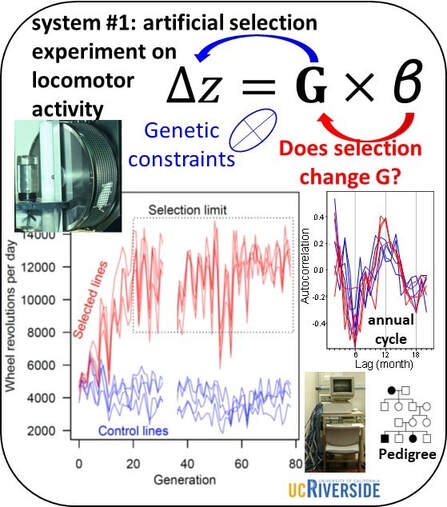Welcome to the Behavioural Ecology and Evolutionary Physiology Lab!
Organisms are the integrated expression of multiple traits that are jointly influenced by developmental, genetic, and environmental factors. Our research tackles the causes and consequences of functional integration among suites of ecologically relevant traits using a variety of approaches (quantitative genetics, experimental evolution, and comparative methods). By examining trait co-variation across multiple levels of organization (e.g., intra-individual, inter-individual, inter-population, and inter-specific levels), we discover how complex phenotypes have jointly evolved into modules of co-adapted traits. Co-adaptation – a key concept in evolutionary biology – is a multivariate process in which traits interact to determine fitness. Thus, our long-term research goal is to test the working hypothesis that metabolic, performance, and behavioural traits are co-adapted with “slow-fast” life-history strategies favoured by particular sets of ecological conditions.
Hiring alert:
Graduate student projects at the interface between behavioural ecology, evolutionary physiology and quantitative genetics
The Behavioural Ecology and Evolutionary Physiology lab is seeking graduate students interested to work at the interface of behavioural ecology, evolutionary physiology, and quantitative genetics. The project is part of a research program aimed at tackling an evolutionary problem in great need of a resolution: the “paradox of stasis” (i.e., we are currently unable to reconcile the lack of phenotypic change observed in wild populations with predictions of evolutionary change). Interested graduate students may choose to work in 1 of 3 study systems that offer unique opportunities to find potential explanations for the paradox of stasis:
|
1) The first system consists of an artificial selection experiment on locomotor activity, in which a stasis is observed despite costant directional selection in the face of genetic variance. Although the replicated control and selected lines are supposedly evolving in a constant environment, there is a striking annual cycle in activity and body mass, which offers a unique opportunity to evaluate how even slight changes in the environment may “mask” evolutionary changes (i.e., “cryptic evolution”). Students working on this project will learn and apply complex quantitative genetics analyses on a giant dataset that contains behavioural and mass measurements on >38,000 pedigreed mice over >78 generations. Travel opportunities may also arise to conduct experiments on the selected mice at the University of California-Riverside.
|
2) The second system consists of laboratory populations of Drosophila melanogaster adapted to life cycles that facilitate comprehensive measures of lifetime reproductive fitness and several underlying components (e.g., viability vs fecundity). This system will be used to evaluate the extent to which trade-offs among fitness components lead to cases of apparent stasis when predictions are based on incomplete fitness measures. Students working on this system will use breeding designs and high-throughput phenotyping systems to conduct cutting-edge analyses of traits that are too rarely studied from a quantitative genetics perspective (e.g., metabolic rate). Work is done at uOttawa in collaboration with Howard Rundle.
|
3) Field-oriented students may work at the Queen’s University Biological Station on a wild population of individually marked white-footed mice. Although the wild-mouse system is a typical monitoring of a wild population, its originality resides in the ongoing measurement of multiple traits that are putative targets of direct selection (potentially more so than ‘traditional’ traits that form the bulk of reported cases of stasis; e.g., body size, which we also measure). Graduate students working on this system will conduct DNA analyses of a large number (~1,500) tissue samples collected since 2016, with the goal of estimating relatedness for applying the multivariate animal breeders equation through “animal model” and selection analyses.
|
How to apply? – Please visit the “join the lab” page here to apply (note: failure to follow instructions increases chances that your application email ends up in spam/trash folder). An external scholarship (e.g., NSERC, OGS, FRQNT) is not required although candidates are strongly encouraged to apply and preference is normally given to those with such funding. Useful information for prospective students at uOttawa can be found here and here. See also various links on my webpage. A minimum salary of $23,000 per year is guaranteed. Those with strong averages (>9/10 for MSc and >8-10 for PhD) also qualify for an admission scholarship that provides free tuition. International PhD students pay tuition at the level of Canadian students (~8000$/year). There is no ideal starting date, but application process is heavily influenced by deadlines for admission scholarships (see above). Applications will be evaluated until positions are filled and budget spent.



